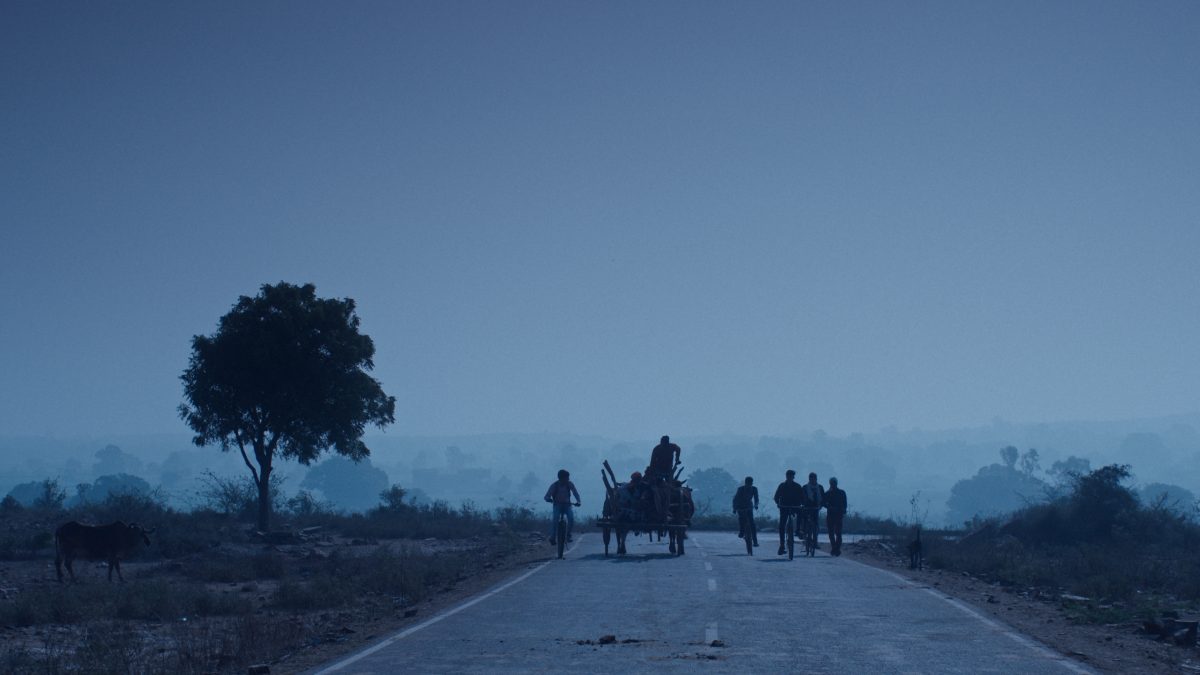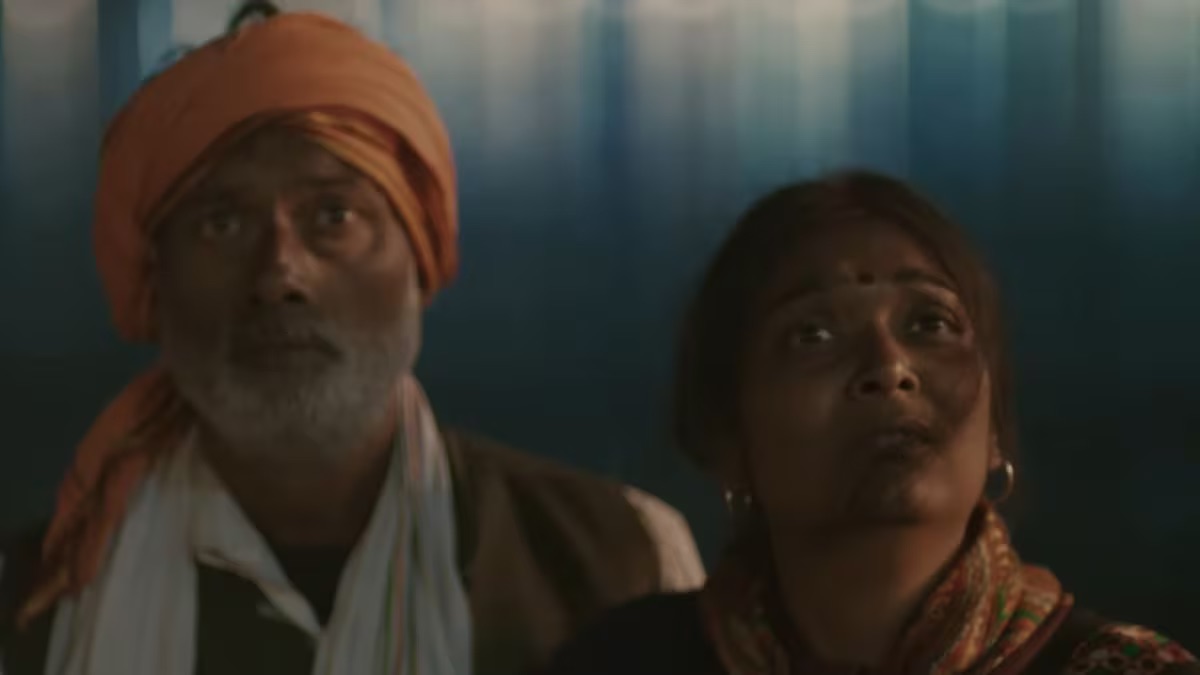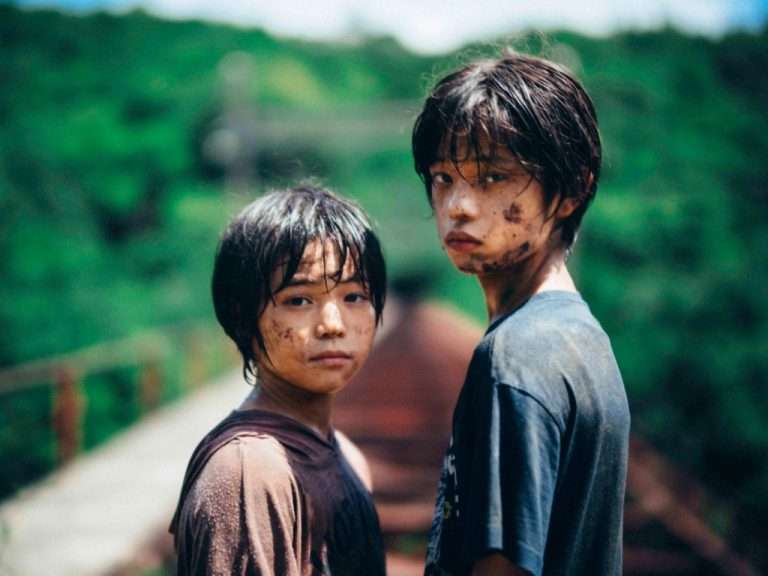Jitank Singh Gurjar’s first feature, “In Search of the Sky” (“Vimukt,” 2025), is a film of hushed subversion—eschewing melodrama and instead locating politics in the everyday rhythms of poverty, marginalisation, faith, and the desires that entwine family with religion. On its surface, we accompany an old couple, Jasrath and Vidya, surviving on the margins of rural Madhya Pradesh, their existence attached to manual labour; he carrying bricks, and she selling cow dung cakes and nurturing their grown son Naran, who has an intellectual disability that makes his value questioned by the same people who are obliged to empathise with him.
The class and caste fault lines are everywhere in the film, and Gurjar doesn’t shy away from showing how tightly they’re woven into the everyday life of rural India, and how they dictate who has dignity and who is discarded. It’s not just that the family is poor; it’s that their poverty interacts with caste prejudice to amplify every burden. The land they live on becomes a pivot of power: a businessman covets it, villagers whisper that perhaps they should sell it off, that it’s too expensive a burden to keep, especially with Naran in need of constant care. Here, caste doesn’t appear in big speeches; it’s in the small murmurs, in assumptions, in who sees them as less.
The villagers’ suggestion that the mother and father might be “better off” without their son isn’t merely about economics. It betrays a social logic in which the disabled are a shame, a drain; in which human value is measured by productivity, by how little one demands from “society”. Vidya’s defiance in the face of this, her insistence that Naran is a gift of God rather than a blot, becomes an act of insurgency against poverty, ableism, and the belief that someone with disability is less worthy of love, care, and inclusion.
Jasrath’s labour is manual, exhausting, and dependent on physical strength; as he ages, his body weakens, and their poverty becomes acute. Yet this physical decline has another dimension: people don’t pity him just because he’s old or tired, but because in their eyes, his inability to sustain the family signals failure, a failure he didn’t choose, but which hierarchies magnify. Disapproval from villagers comes with moral judgments, “this must be because of sin”, “this is the result of bad karma”, which don’t just hurt spiritually but also deprive the family of community support and empathy.
The roads, the sky, and the pilgrimage path in the film become sites of both oppression and possibility. The film opens in the cramped, fractured spaces of rural Madhya Pradesh: mud‑walls, the kiln, the small fields, the family’s own land. Here, space is limited. It is suffocating. The father hauls bricks, the mother sells cow‑dung cakes; their son, Naran, with intellectual disability, lives in a home where physical labour, class, caste, age, and disability intersect to define which spaces one may occupy and which one must endure. These opening spaces of small, bounded, harsh cubes reflect the disciplining presence as to what land you can hold, how far you can move, what kind of labour you must perform, and what kind of speech (or silence) is allowed.

The pilgrimage to the Maha Kumbh Mela is a transformation of spatial scale. The journey on the roadway to the Kumbh is filmed in wide shots; the sky opens up, and horizons stretch. The aspect ratio opens up when the setting moves to Kumbh Mela, shifting from tighter, more realistic frames to more expansive, surreal ones. The road becomes a sense of possibility, divinity, and a kind of liminal zone where social hierarchies might be challenged. You see millions gathered, the river flows, and in that gathering, the sheer scale offers a counterpoint to claustrophobia at home. Amid the throng, the holy dip becomes more than ritual; it is the act of being visible, of affirming one’s humanity, of merging into a collective greater than the class and caste hierarchies that in the village reduce or erase you.
This contrast reveals the political tension: spatiality vs constraint. At home, space is a site of constraint. There’s no escape from caste stigma, poverty, and disability. Even nature or land is not safe – the land is both a resource and a burden; possession of land means survival, but also draws predatory attention. But on the pilgrimage road, the sky, the river, and the open crowds are symbolic and literal expanses. The wide frames of countless pilgrims, the river rising, the crowds dissolving into anonymity—together they evoke a realm where caste lines soften, where social divisions appear fragile, if not overturned.
When Vidya and Jasrath travel, it’s almost as though they are crossing from one order (the oppressive, judgmental, limited space of the village) into another (mass pilgrimage, ritual, belief, possibility). But Gurjar doesn’t promise that openness cures everything. The ending is ambiguous. The escape to divine space is not a mere deus ex machina.
Also Read: Upcoming New Movies: 2025 Movie Release Date Calendar
The film shows that faith is essential, maybe the only recourse, but the social structures of caste, class, and ableism don’t dissolve just because you reach a holy river. The belief in divine power (the Maha Kumbh) becomes their hope for healing or relief, especially for Naran’s condition. Still, this belief is political, because faith is one of the few resources left to the poor and marginalized. It becomes a form of leverage: can ritual sanctity, divine gaze shift how others see them? Can it shift how they see themselves? The pilgrimage then isn’t just spiritual, it’s political, an insistence.
The blue in the film is not a whimsical cosmetic effect, but the strand that weaves together hope, exclusion, faith, and struggle. Blue becomes here theology, geography, and the politics of sight. From the first frame, sky and water speak in hues of blue: the soft, washed tones of dawn and dusk; the dark, trembling depths of a river illuminated by ritual; the icy cerulean chill that settles in moments of doubt and shame. It is in the quiet before the mother wakes, in the reflection of the Ganga in morning light, in the far horizon of the distant highway when the family departs for the pilgrimage: blue is at once everywhere a promise and a bruise.
When the people look up, the blue in the sky is a political assertion: that one born disabled, one from the margins, has a sky. The pilgrimage road stretches into wide shots where daylight spills in sky-blue hues, vast and transcendent, counterpointing the earth-brown and dust-gray tones of the village interiors. There, the light is harsher, tighter, colour more muted, suppressed. Blue only intrudes in glimpses: a sliver of sky between a room and a roof, the Ganga glimpsed from a distance, possibly blue garments washed and drying in the air. Each glimpse feels like a small rebellion—a son’s survival, a mother’s devotion, a belief that reaches beyond the ordinary. Still, blue presses down with the weight of exclusion, a color that feels cold, remote, untouchable. The distance between how society dismisses Naran and how his family believes in him is etched in this vivid, lonely hue.

For Vidya and Jasrath, the Ganga’s blue at the holy dip is less about spectacle than about hope—that the divine might break through social walls, restore worth to Naran, and for a moment free them from the unseen binds of caste, shame, exclusion. The water washes hands, but more than that, it washes and rekindles faith. In its flow and shimmer, in its ceaseless movement, it gathers the hues of human sorrow and desire, and offers back something both tender and immense.
“In Search of the Sky” is cinema, but also an unhealed wound we’ve refused to acknowledge. It rips open the ways patriarchy, caste, poverty, and ableism conspire to muffle women’s voices, insisting that we look, that we listen. Vidya, the mother, is both fist and heart: she raises Naran when others see him as a disgrace, will not be silenced, will not be reduced to pity, and holds fast to faith—not out of blind credulity, but out of a fierce devotion born equally of love and rage.
The feminist ethos of the film is in her refusal to be asked to be invisible or complicit in her son’s disappearance just because he has intellectual disability. She is burdened with drudgery, social censure, and murmurs that they should leave him, yet her resistance is potent. Here she is personal, yet political—defying the idea that women, cast as nurturers, must absorb shame each time those they love are forced into oppression.
Jasrath’s shame, the community’s passive malevolence, both reveal just how low patriarchy expects women to internalise the cruelties of society and shut up. But she doesn’t. She stakes her claim on pride, for her son, for herself, for the family by virtue of defiance in the mundane. The journey to Maha Kumbh becomes both a search for hope and a rhetorical ground upon which belief becomes a weapon: for Vidya, faith has little to do with surrender, and everything to do with taking a hold of voice.
“In Search of the Sky” is a political act of vision—forcing us to see what society prefers to hide. It demands outrage, insisting that dignity, care, and visibility are rights, not privileges. Confronting how caste, class, and ableism silence women and erase the disabled, it calls us to justice. This film deserves not only praise, but insistence, disruption, and change.



![Another Round [2020] Review – When Honesty Overcomes Moralism](https://79468c92.delivery.rocketcdn.me/wp-content/uploads/2020/11/Another-Round-highonfilms-1-768x432.jpg)
![Wandering Earth Netflix [2019] Review: A disappointing Hollywood disaster flick with a Chinese flavor](https://79468c92.delivery.rocketcdn.me/wp-content/uploads/2019/03/Wandering-Earth-2019-High-On-Films.jpg)

![Seal Team [2021] Netflix Review : Seals vs Sharks battle for survival loses itself to incoherent execution](https://79468c92.delivery.rocketcdn.me/wp-content/uploads/2022/01/Seal-Team-2021-768x432.jpg)
![Directions [2017]: ‘TIFF’ Review](https://79468c92.delivery.rocketcdn.me/wp-content/uploads/2017/09/directions_01-768x384.jpg)
![Sivapuranam [2015] MUBI Review – A strange isolated world of a loner](https://79468c92.delivery.rocketcdn.me/wp-content/uploads/2020/05/The-Strange-Case-of-Shiva-Sivapuranam-2015-Review-768x432.jpg)